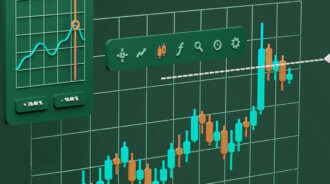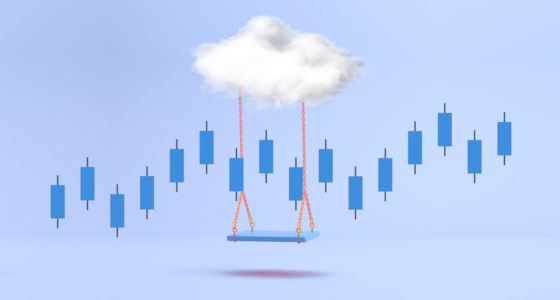

Traders use a variety of technical indicators to help them make trading decisions based on their chosen strategy and trading style. In this article, we will explore some of the top technical indicators for options trading and also discuss the calculations associated with these indicators. But first, let’s familiarise ourselves with the terminology of options.
What is options trading?
Options trading is a straightforward concept: one can purchase an option contract from someone who already owns one or more contracts. With call options, an individual has the right (but not the obligation) to buy shares at a predetermined price by a specific future date.
The holding period of options is crucial for traders as they are subject to time decay.
Options have an expiration date, which limits the trader’s timeframe. In contrast, a stock trader can hold a position indefinitely. Therefore, options traders often use momentum indicators to identify levels of overbought and oversold conditions.
Now, let’s explore the best technical indicators for options trading.
Relative Strength Index (RSI)
The Relative Strength Index (RSI) is a top indicator for options trading that helps traders analyse price trends. It can determine when a security is overbought or oversold and identify potential turning points in price movement. The RSI compares recent price movement to prior movement to gauge the momentum of price fluctuations.
The RSI provides two main signals: overbought and oversold. When an asset is overbought, the market is excessively optimistic about its future performance.
Conversely, when an asset is oversold, the market is overly pessimistic about its future performance.
The RSI uses a scale of 0 to 100 to calculate its value. A high RSI, typically above 70, suggests overbought levels. In this scenario, investors believe the price of the security will likely increase over time, as they expect it to outperform other securities in the same category. On the other hand, a low RSI, typically below 30, indicates oversold levels, indicating that investors anticipate the price of the security to decline over time.
Technical analysts typically apply the RSI indicator to trading options on stocks rather than indexes. High-beta stocks tend to exhibit a volatile RSI value, frequently touching overbought and oversold conditions. This makes the RSI an effective indicator for short-term trading.
Bollinger Bands
Bollinger Bands are excellent technical indicators for options trading, as they measure volatility in price action. The width of the Bollinger Bands reflects the level of volatility: as the volatility of a security’s price increases, the bands expand, and as the volatility decreases, the bands contract. This indicator, based on a moving average, can determine if an asset is overbought or oversold over a specific period.
When the price of an asset approaches the upper band, it suggests that the market is inclined to allow the price to follow a bullish trend. Conversely, when the price moves toward the lower band, it indicates a potential bearish trend.
Bollinger Bands enable traders to capitalise on market volatility by identifying trends and breakout opportunities. Price fluctuations outside the bands can signal a reversal in price momentum. When the price moves outside the bands, it indicates that the security may be primed for a reversal, allowing options traders to position themselves accordingly. For example, after a breakout above the top band, a trader may consider initiating a long put or a short call position, and vice versa.

Intraday Momentum Index (IMI)
The Intraday Momentum Index is undoubtedly one of the best indicators for day trading options. IMI generates signals by combining certain aspects of RSI and candlestick analysis. It analyzes the correlation of opening and closing prices during the 1-day timeframe rather than the variation between days. This allows the traders to predict when the security is overbought or oversold during an intra-day trading session.
The calculation of IMI is straightforward; it looks at the relationship between “up closes”, i.e., the closing price is greater than the opening price, and “down closes”, i.e., the opening price is greater than the closing price. It is the proportion of gains on “up closes” over the total gains and losses on up and down closes over a period “n”. The value of “n” is generally taken as 14 days.
The value of IMI can be interpreted just like the RSI; if the value is above or equivalent to 70, the security is overbought and can be anticipated to go up. And if the value of IMI is below 30, the market is overselling, and the price can observe a downtrend.
Note! The intraday indicators are typically considered more beneficial for trading in the short term instead of the long term.
Money Flow Index (MFI)
The Money Flow Index (MFI) is one of the best options trading indicators that helps traders generate overbought and oversold signals. It takes into account price and trading volume data for a particular security. The analysis of IMI is coherent with the relative strength index; hence it is often denoted as volume-weighted RSI.
The MFI reading oscillates between 0 and 100. The higher an asset’s MFI, the more active it appears to be and, therefore, the greater demand for a position. A high MFI above 80 indicates strong buying interest, and a low MFI below 20 indicates strong selling interest. Interestingly, the MFI value can exhibit divergence, i.e., movement of MIF opposite to the price direction. This divergence typically suggests a reversal in the price trend, and traders watch these divergences for potential trading opportunities, making it one of the reliable indicators for binary options trading.
Put-Call Ratio (PCR) Indicator
The put and call option gives the buyer the right to sell or buy an asset at the strike price respectively before the expiration date. The put-call ratio is a formula that helps to determine whether an asset is overbought or oversold based on the relationship between put options and call options. When more put options than call options are available for trading, PCR is greater than 1, signaling a bearish trend. Contrary, when there are more call options than put options, the ratio is less than 1, and the investors expect a price rise, which signals a bullish pull.
PCR indicator for options trading provides a good evaluation of overall market sentiment; hence it can also be used in contrarian investing strategy. The trader looks for extreme put-call ratio values, which indicate a strong bullish or bearish trend; then, a trader might want to invest against market sentiment. These signals are valid because the undue bullish pulls and bearish signals do not last long enough and are subject to reversal.
Open Interest (OI)
Open interest is a measurement of the total number of outstanding open contracts that still need to be settled. It is one of the best chart indicators for options trading, representing the capital flow in and out of the market. Open interest, as its name suggests, indicates open positions that still need to be closed, expired, or settled. A high level of open interest can demonstrate that more contracts are open than the number of closed positions. This means that traders closely analyze the asset, which has significant potential for volatility in price movement.
Open interest portrays the market’s interest in the sustainability of the ongoing trend. A similar trend of price movement and OI values can be interpreted as a positive indication for the continuation of the trend. For instance, a rising price trend and a rising OI value suggest that there is an inflow of capital into an asset, and it will continue its uprising trend.
FAQs
Let’s look at a few questions about options trading.
Can I place limit orders on options?
Yes, you can place a limit order. The order will be complete when options contracts are available at your specified price. On the other hand, you can also place a market order to be filled immediately at the market price.
What determines the price of an option?
The price of options trades can be determined by five parameters: current price, strike price, expiration date, interest rate, and asset volatility.
What are the risk measures used with options?
Traders typically monitor five Greek risk measures to analyze option risks. These include Delta, Gamma, Vega, Theta, and Rho.
The bottom line
The options trading indicators discussed in this article are all essential to know as an options trader, but their usefulness is determined by trading techniques. Also, it is crucial to understand their limitations and how experienced traders use them. Which indicators are best for options trading depends upon the trading strategy and style. To be profitable, research the merits of each and decide which indicators are best for your options trading.










